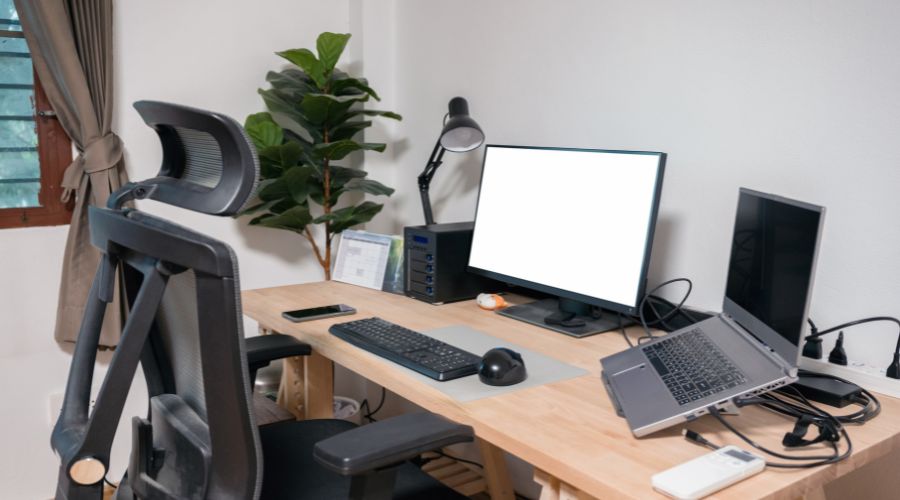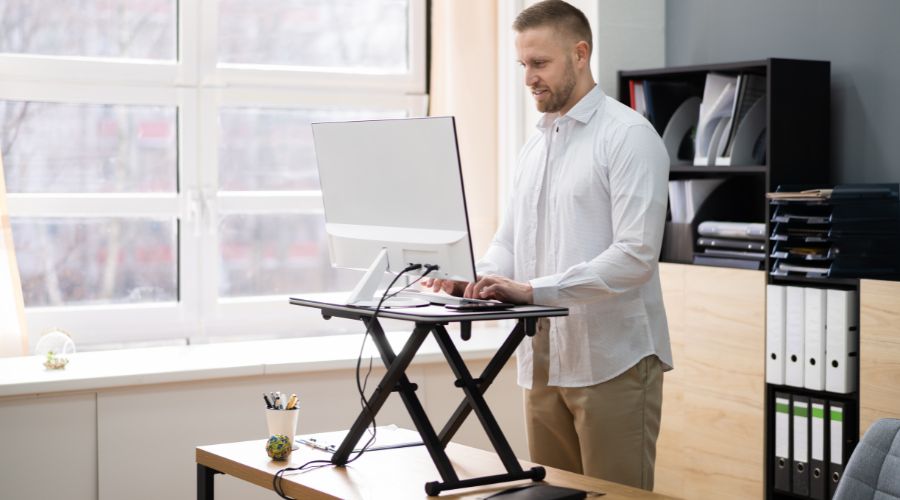Most business owners and managers understand that to get the best out of the people you work with, you must treat them well. The positive momentum and enhanced morale engendered by kind and fair treatment help create a more motivated and productive workforce.
Source: Business.com
However, few management-level professionals realize that “kind and fair treatment” should extend to employees’ physical environments. Specifically, creating ergonomically optimized workspaces can protect your team’s health while helping to create a happy and productive work culture. We’ll explain more about ergonomics and why employers should invest in ergonomic workstations to boost productivity and morale.
What is ergonomics, and what is an ergonomically designed workstation?

Ergonomics is an applied science that studies people’s efficiency in their working environment. More specifically, it involves designing and organizing the elements people interact with. Ergonomics is also referred to as biotechnology, human factors and human engineering.
An ergonomically designed workstation is a personalized workspace that abides by ergonomic best practices to help individual workers maximize efficiency and safety. Everything in an ergonomically designed workspace is situated to help prevent injuries, reduce repetitive movement and ensure the environment helps the employee work as efficiently and comfortably as possible.
How ergonomics improves productivity
Ergonomics increases productivity by providing an individualized workspace where workers can feel comfortable physically and mentally. Ideally, focusing on workstation ergonomics and factors like improved posture helps employees stay more engaged, healthy and alert.
1. Ergonomic workstations help employees stay healthier.

Many business owners understand that taking measures to reduce sick days and workplace injuries is crucial. Occupational Safety and Health Administration compliance is mandatory to help provide a safe work environment for your employees and ensure their well-being. However, many leaders are unaware that daily repetitive strain – not falls or lifting heavy equipment – causes numerous injuries that lead to unavoidable workplace absenteeism and reduced productivity.
Repetitive strain injuries take a long time to develop and typically require lengthy treatment and healing periods. As a result, they can lead to extended absences for highly skilled employees. This situation results in lost productivity and could cost your company significant money in increased workers’ compensation rates. You may also have to pay overtime to staff members who must cover for recuperating employees, adding to your payroll liabilities.
Additionally, injury and discomfort have other, less apparent repercussions. You may experience lowered employee retention and face the costs of hiring and training new employees. No one will last long in an unhealthy and uncomfortable environment, so your turnover rate can spiral.
2. Ergonomic workstations keep employees more engaged.
Providing your employees with an ergonomic environment shows that you take their health and well-being seriously – a message strongly linked to improved employee engagement.
When you give an employee ergonomic equipment to work with, you tell them, “How you feel matters to me; I want you to be happy and comfortable, and I want to protect you from harm.” Some of the most successful companies in the world, notably Google, have mastered the creation of ergonomic and enriched workspaces to ensure their employees have high morale and feel free to think creatively.
3. Ergonomic workstations keep workers more comfortable and alert.
Workers who are often uncomfortable and in pain often report feeling tired, which reduces their ability to perform effectively. They must also take frequent breaks to stretch, walk around or lie down to reduce muscle strain.
Physical pain negatively impacts mental energy too. It’s hard to feel inspired, solve problems or generate new ideas when you’re distracted by physical discomfort. When an ergonomic workstation improves employee comfort, workers can enjoy heightened awareness.
4. Ergonomic workstations help employees work more efficiently.

Ergonomic equipment often makes an employee’s work easier to complete, reducing repetitive motions and optimizing posture.
For example:
- Ergonomic keyboards can help employees type faster and take fewer breaks.
- Ergonomic cleaning equipment helps janitorial teams clean large areas without having to bend frequently.
- Ergonomic computer monitors are designed to reduce eyestrain, enabling employees to focus on their screens for more extended periods without developing headaches.
- Ergonomic chairs help improve posture.
This equipment helps workers work more efficiently and productively with higher-quality output.
How an ergonomic focus helps the bottom line
The healthier your team members are, the more they can contribute to the business’s bottom line – a win-win situation. Consider the following ways ergonomically designed workstations improve business outcomes:
1. Ergonomic workstations reduce labor costs.
According to the most recent data from the United States Bureau of Labor Statistics (BLS), ergonomic injuries accounted for nearly 55 percent of emergency room visits for workplace injuries, leading to necessary time off for injured workers. For example, the most recent BLS data says the median days off spurred by carpal tunnel issues is 28.
By reducing the likelihood of workers developing disorders like carpal tunnel, muscle strains, tendinitis and rotator cuff injuries, your business will save money and your employees will be present more often.
The less time an employee spends out of work because of medical issues, the more time they can give your company, which benefits both the employee and the business.
2. Less movement to complete a job means an increase in productivity.

An ergonomically sound workstation allows employees to focus on their jobs instead of wasting energy making their chairs comfortable, resting their hands on their desks correctly or going out of their way to complete daily tasks. New technology, including automated ergonomic assessments, has made it possible to take ergonomics to the next level.
When you create a more efficient workstation, employees’ posture improves. As a result, they make fewer motions, exert themselves less and become more efficient.
3. Ergonomic workstations lead to fewer errors.
If employees must go out of their way to adjust their positions and make their workspaces comfortable, their energy is drained. They have less focus and incentive to pour into their actual duties, leading to more mistakes and longer lead times.
When you add up the various costs incurred by failing to invest in ergonomics, it becomes apparent that ergonomic equipment is not a luxury – it’s a necessity.


